Choosing the Right Hair Dye Color for You
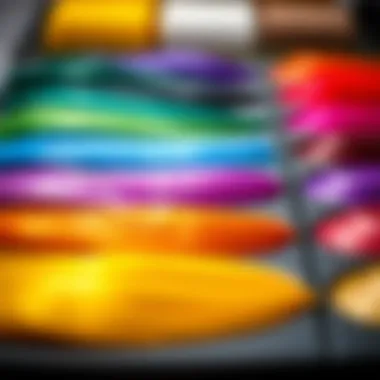
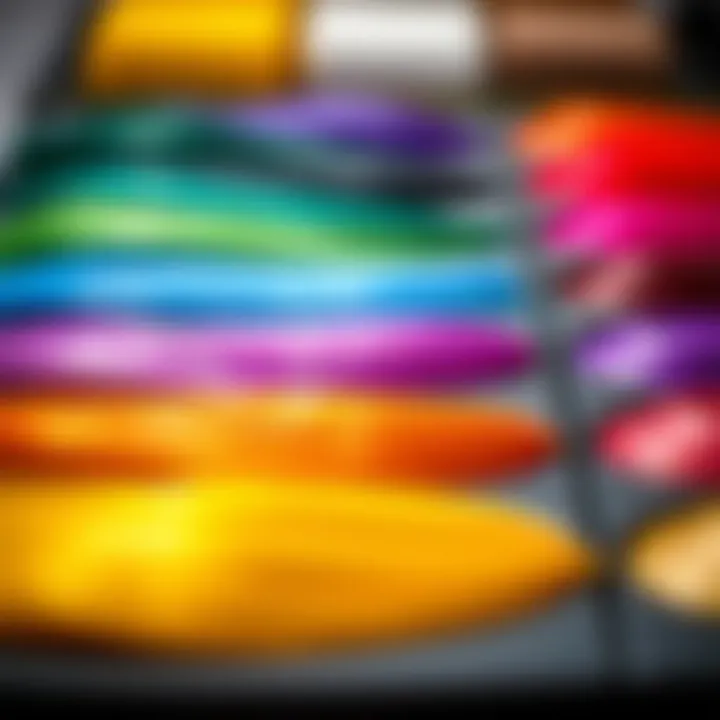
Intro
Choosing the right hair dye color isn't just about picking a shade off a shelf. It's about understanding how that color interacts with your unique features, personality, and lifestyle. When faced with an overwhelming array of options, many may feel stuck at the crossroads of creativity and practicality. This article aims to shed light on the nuanced art of hair color selection.
Your skin tone, eye color, and even your daily habits play significant roles in the dye process, influencing which shades will flatter or fall flat. Not to mention, there are prevailing trends in the beauty world that might beckon you to try something new. Whether you're aiming for a bold statement or a subtle enhancement, determining your optimal hair color is about more than just trends.
You'll find that we delve deeply into how these personal characteristics affect hair dye choices while highlighting the key trends that are making waves today. Additionally, we aim to provide valuable tips for maintaining your color and hair health over time, ensuring your choices remain both stylish and sustainable.
Come along on this journey, where artistry meets personal expression, and be prepared to uncover insights that resonate beyond the mirror.
Understanding Hair Color Basics
When it comes to choosing a hair dye, understanding the underlying principles of hair color is paramount. This section lays the foundation for selecting a shade that enhances one’s unique features while aligning with personal style. Having a solid grasp of hair color basics can aid you in making informed decisions, steering clear of common pitfalls that can lead to dissatisfaction or costly corrections.
Hair color is not just about picking a shade you like; it’s also about how that shade interacts with your skin tone, eye color, and even your personality. More than a mere superficial change, hair dye can significantly impact your individual aesthetic.
The Science of Hair Color
At its core, hair color results from the combination of natural pigments in the hair, mainly melanin. Melanin comes in two forms: eumelanin and pheomelanin. Eumelanin provides shades of brown and black, while pheomelanin yields the lighter tones, such as blond and red. The proportions of these pigments dictate your natural hair color.
Understanding this science can help you better select colors that complement your natural beauty, rather than clash with it. For example, knowing how to differentiate between your warm and cool undertones can guide you in choosing hair dye shades that harmonize with your skin.
Types of Hair Dye
Diving into various types of hair dye is crucial, as each serves a distinct purpose and comes with its unique set of characteristics. Choosing the right dye type can meaningfully affect not just the look, but also the health and longevity of one's hair.
Permanent vs. Semi-Permanent
Permanent and semi-permanent hair dyes hold different benefits and applications. Permanent dye is formulated to provide long-lasting color and often requires a developer to penetrate the hair shaft. A key characteristic of permanent dye is its ability to lighten natural hair color, making it a go-to option for those who wish to drastically change their appearance or cover greys completely.
On the other hand, semi-permanent dye imparts color without altering the hair structure as significantly, which means it can fade over time, usually lasting anywhere from a few weeks to a couple of months. This type is a popular choice for those who seek to experiment with color without the long-term commitment. It’s often sought after by first-time users, as it's less daunting than its permanent counterpart. However, its inability to lighten hair can limit its scope for drastic changes.
Temporary Solutions
Temporary hair dyes are a fantastic option for those looking to make a short-term change or just try out a new look. These dyes coat the hair shaft and wash out after a few shampoos. Key characteristics of temporary solutions show they can come in various forms, from sprays to foams, offering versatility and ease of application.
A significant advantage of temporary dye is its immediacy: if you don’t like it, you can rinse it out with little fuss. This type of dye allows for creative expression, especially in vibrant colors that one might not want on a permanent basis. However, the drawback lies in their ephemeral nature; if you want a color that lasts, you'll eventually need to reconsider your options.
Natural Dyes vs. Synthetic
With increasing awareness about the impact of chemicals, natural dyes have seen a surge in demand. These dyes often use plant-based ingredients, such as henna or indigo, to achieve specific colors. The key characteristic of natural dyes is their less abrasive formulations, making them suitable for sensitive scalps or those aiming to limit exposure to synthetic chemicals.
However, while they might be gentler, natural dyes can also lack the variety and vibrancy offered by synthetic alternatives. Synthetic dyes are typically more reliable in delivering rich and vivid colors that compete in the marketplace. Yet they may come with long-term concerns, like hair damage due to strong chemicals used in formulations.
In summary, knowing the ins and outs of hair dye types is crucial for anyone looking to change their hair color effectively. By grasping the differences between permanent, semi-permanent, temporary, and natural vs. synthetic options, one can select a hair color that not only suits personal style but also encourages healthy hair care practices.
Assessing Your Individual Features
Determining the perfect hair dye demands more than just picking a color from a chart. It's an intricate dance between your individual characteristics and the hues that might complement or clash with them. Assessing your unique features is integral because it leads to choices that reflect your own self, rather than just following trends. Specific elements of this assessment include skin tone, eye color, and even lifestyle that can greatly enhance or undermine chosen shades.
Skin Tone Considerations
Cool Undertones
Cool undertones are characterized by hints of blue or pink in the skin. Noticing this often occurs when, against a stark white backdrop, one’s veins appear bluish rather than green. Choosing colors like ashy blondes or deep plums often brilliantly elevates the overall look of those with cool undertones.
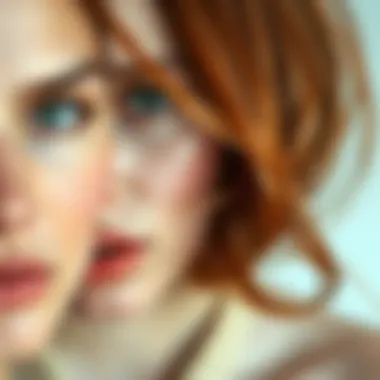
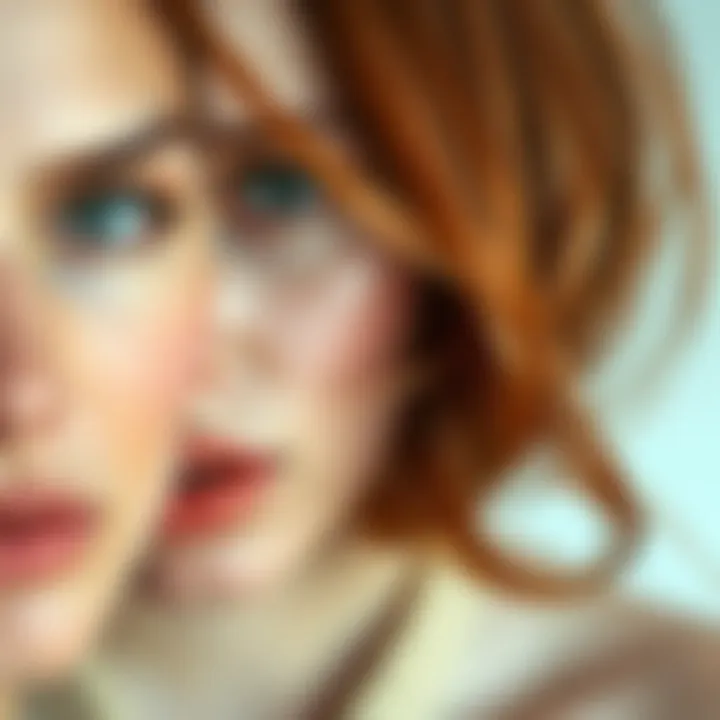
One of the main benefits of selecting hues that align with cool undertones is that it tends to create a harmonious appearance. It can be a real gamechanger, as it adds depth to your features; however, beware that not all colors will resonate well. For instance, when someone with cool undertones opts for golden hues, they might find their complexion looks washed out rather than radiant. Cool undertones are definitely popular, but finding the right shade requires a careful balance.
Warm Undertones
Warm undertones are those with a golden or yellow hue to them. If you find that silver jewelry appears dull while gold shines, you're likely in the warm category. Colors, such as warm browns or honey-blonde shades, become a nurturing wash over the complexion.
This undertone often resonates well with shades that mimic the hues of the sunset. They help create a glow that seems to emanate from within. A drawback, though, is that if someone with warm undertones goes for a cooler shade, they might end up looking a touch sallow. Still, the variety of rich colors available for warm undertones makes them an appealing choice overall.
Neutral Shades
Neutral shades are a beautiful blend, coming equipped with both warm and cool tones, making it easier to pull off a broader range of colors. For those with neutral undertones, managing to wear colors from both sides of the spectrum opens up possibilities that many others may not enjoy. Having this equality in undertones often means a more expansive color palette.
While neutral shades facilitate a versatile selection, there can be a slight challenge in feeling that balance with certain colors. It may require some experimentation. However, the freedom it provides is one that delights many individuals looking to explore hues vibrantly.
Eye Color Influence
Complementary Colors
Eye color plays a crucial role in determining favorable hair shades that enhance your natural beauty. Consider blue eyes, which often sparkle brighter when paired with complementary shades of copper or auburn; they add depth and dimension. This plays into the simple notion that what complements usually elevates a person’s overall appearance.
When embarking on this journey of choosing hair color, one needs to be mindful of how their eye color merges with their selection. Picking complementary colors generally leads to a more unified and attractive look, allowing one’s eyes to pop. Of course, opting for the wrong hues can create an unwanted contrast; thus, knowledge here is essential.
Enhancing Natural Features
The idea of enhancing natural features through hair color is not merely superficial; it speaks volumes about creating a well-rounded appearance. For example, someone with bright green eyes might find that deep chestnut colors bring out their richness in a way that simply changes how others perceive their features altogether.
The beauty of enhancing natural features lies in its personalization. It allows for a unique expression of self while highlighting elements that make a person distinctive. Though this does require a careful thought process and sometimes extensive experimentation, successfully aligning one’s hair color with natural features can instill an immense sense of confidence.
When pushed along by both skin tone and eye color, assessing these features propels individuals toward a dye choice that resonates with who they are. So dive deep into this venture, take note of undertones and hues, and embark on a colorful journey toward self-expression.
Exploring Hair Color Trends
In the ever-evolving landscape of beauty and personal expression, hair color trends hold a significant place. Understanding these trends can enhance one's experience when selecting a dye, fulfilling the desire not just for aesthetic appeal but also for personal expression. What's trending today may very well be a reflection of broader cultural movements, artistic interpretations, or even lifestyle changes. By immersing oneself in contemporary trends, one can discover ways to not only align with current fashions but also personalize them to fit one's unique identity.
Fashion trends can act as a compass for those uncertain about their next hair color choice. The dynamic patterns that emerge each season often highlight colors that can be unexpectedly flattering or add a much-needed twist to one’s look. Prospective dyers may find that incorporating one of these trends can elevate their overall aesthetic, making it feel fresh and bold.
Balayage and Ombré Techniques
These two popular techniques encapsulate the beauty of blending colors to create dimension and movement in the hair. Balayage is essentially a hand-painted highlighting method that infuses subtlety and softness into locks. It's about having a touch of lightness that appears sun-kissed, and it works beautifully across various base colors. On the contrary, the ombré technique produces a more dramatic gradient effect, transitioning from a bold or dark root to a lighter tip.
Both methods cater to the desire for low-maintenance color. Since they grow out gracefully, the need for frequent touch-ups is minimized, making them an appealing option for those who prefer a more laid-back hair care routine. Moreover, these techniques suit a plethora of tonal variations, ensuring it's adaptable for almost everyone.
Fashion Colors: Bold Choices
Embracing such unexpected and vibrant options reflects a courageous spirit. Here’s a closer look at some specific aspects of these lively colors:
Pastel Hues
Pastel hues have taken the hair dye world by storm, aiming for a soft, dreamy palette that feels fresh and young. These lighter shades lend an air of whimsy and personality, inviting curiosity without overwhelming the observer. The key characteristic of pastel colors is their ability to create an almost ethereal appearance, making them a popular choice for those wishing to stand out while maintaining a certain elegance.
However, it’s worth noting the unique feature of pastels: they often require pre-lightening, which can be harsher on the hair. This necessity for preprocessing may turn some potential users away. Still, the outcome can be a visually stunning statement that elevates the ordinary into something remarkable.
Vivid Tones
Contrasting with pastels, vivids are unabashedly bold and energetic. These colors exude confidence, making them an appealing choice for those wanting to express themselves loudly and proudly. The key characteristic of vivid colors lies in their saturated nature, allowing for vibrant expressions that can command attention.
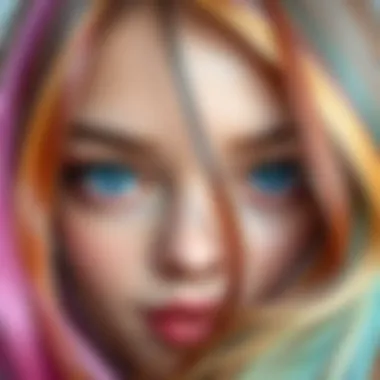
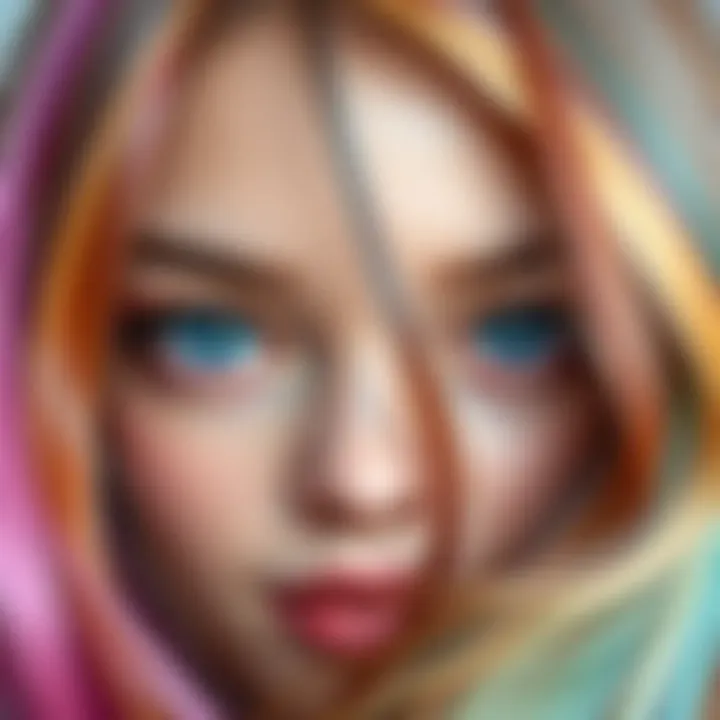
Vivid tones also present advantages and disadvantages alike. While they often provide a striking visual impact, they generally demand regular upkeep, particularly in maintaining the intensity of the shade, which can be an intricate dance of color-challenging maintenance.
Metallic Shades
Lastly, metallic shades offer a unique twist that feels both modern and luxurious. These tones can reflect light in a captivating way, enriching the appearance with a brilliant shimmer. Metallics are often perceived as edgy, catering to those who are keen to step away from traditional color choices. The key characteristic of these shades is their ability to shine and stand out, making them a focal point of any hairstyle.
Yet, as with other vibrant colors, metallics may involve a higher maintenance commitment, particularly in touch-ups and the use of special shampoos and conditioners formulated to prevent fading. Thus, while they can be incredibly stylish, prospective users must be prepared for a bit of a commitment in their hair care routine.
Exploring fashion color trends offers a unique opportunity to express one’s identity. It's essential to weigh the commitment against the desire for vibrant self-expression when considering these bold choices.
Maintenance and Commitment
Choosing the right hair dye color is only half the battle; the real test lies in the ongoing maintenance and commitment required to keep your locks looking vibrant and healthy. Hair dye, while transforming, can also introduce a whole new set of challenges. Knowing how to navigate these can mean the difference between a dazzling color and a dull, lackluster appearance. Moreover, the care routine that follows application is crucial to ensuring that the hair dye lasts, the scalp remains healthy, and the overall appearance is nothing short of stunning.
Frequency of Touch-Ups
When it comes to hair dye, timing is everything. As your hair grows, the natural color at the roots re-emerges, which can create an unattractive contrast against previously dyed lengths. Thus, the frequency of touch-ups becomes an essential aspect of maintenance. Whether you’ve gone for a bold platinum blonde or a rich auburn, the regrowth process is akin to watching paint peel—swift and unavoidable.
Generally, the touch-up schedule can differ based on the dye used:
- Permanent dyes typically require appointments every 4 to 6 weeks.
- Semi-permanent options may need refreshing every 6 to 8 weeks.
- For colors that are strikingly different from your natural shade, you might want to lean more on the shorter end of that spectrum.
However, factors like hair growth rate, desired color vibrancy, and lifestyle can influence this timing significantly. All things considered, consistent touch-ups not only keep your color on point but also contribute to an overall polished look.
Effective Hair Care Routines
Maintaining dyed hair requires more than just touch-ups. A well-thought-out hair care routine will keep your color from fading too soon and your strands from fraying. Two essential components of this routine are proper shampooing and conditioning, alongside effective heat protection and styling methods.
Shampoos and Conditioners
Selecting the right shampoo and conditioner can set the initial tone for maintaining your hair color. It’s vital to pick formulas that are specially made for color-treated hair. These products often lack harsh sulfates, which can strip hair of its dye and moisture. For example, many brands offer color-safe, sulfate-free options that gently cleanse without compromising the richness of your hue.
- Key Characteristics: Look for terms like "moisturizing" or "anti-fade" on the bottle. These indicate that the formula works to preserve the vibrancy and integrity of color-treated hair.
- Benefits: Keeping dyed hair nourished assures that the vitality of color remains intact for a longer stretch.
A unique feature many of these shampoos possess is the inclusion of UV filters which help protect against sun damage. However, be mindful of over-washing—this can lead to dryness, making colors appear lackluster. It’s often suggested to wash no more than two to three times a week.
Heat Protection and Styling
Lastly, heat protection and styling cannot be overlooked. Excessive heat can wreak havoc on color-treated hair, leading to premature fading and damage. Using a heat protectant spray before any styling methods is an absolute must. These sprays create a barrier that shields your strands from damage caused by mechanical and thermal processes.
- Key Characteristics: Heat protectants often include silicones and nourishing oils, which not only help lock in moisture but also create a smooth surface for styling.
- Benefits: This practice significantly reduces the risk of breakage and color depletion.
While styling tools can achieve desirable looks, always remember that moderation is essential. Alternating heat-based techniques with no-heat options, like braiding or styling with hair clips, preserves both the hair health and color richness.
Consistent care is key; treat your dyed hair like gold—give it the attention it deserves!
Personalization and Self-Expression
Choosing a hair dye color goes beyond just picking a shade that looks pretty or is trending. It’s about embodying personal identity and expressing one’s individuality in a way that resonates deeply. Personalization means finding that unique balance where your hair reflects who you truly are—your values, your mood, and even your lifestyle. In a world that often pushes conformity, hair dye becomes a canvas for self-exploration and creativity.
When you take the time to personalize your hair color, you enable an expression that is entirely your own. Think of it like writing a signature—no two are exactly the same. Whether you prefer the soft, subtle touch of a balayage or the boldness of a vivid hue, the choices you make can speak volumes about you.
Importance of Personalization
- Identity Assertion: Hair is more than strands; it’s an extension of personal identity. Choosing a color that resonates can boost confidence.
- Creative Outlet: Dying hair offers a way to experiment. It's a form of art, offering you avenues to break the mold.
- Adaptability: As preferences and seasons change, hair color offers a way to evolve. This adaptability is an integral part of self-expression.
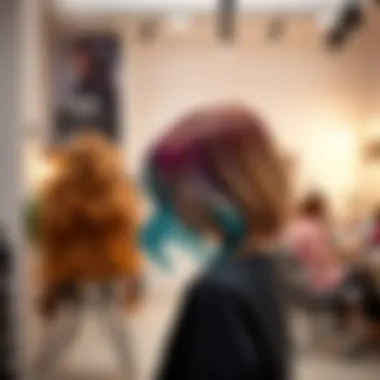
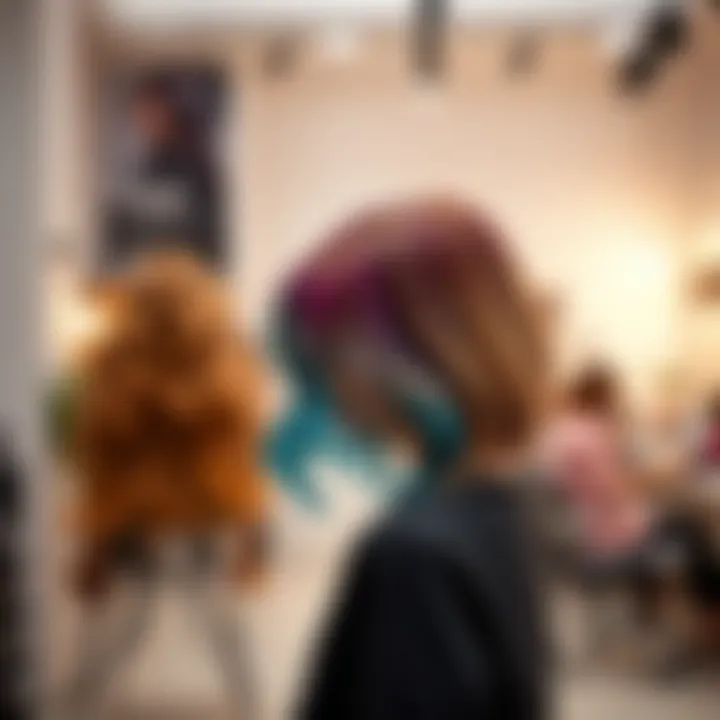
Personalization shouldn't be rushed. It requires reflection on your experiences, culture, and even professional image. Consider this: how does your chosen hair color play with your sense of self? Making the right choice often involves asking important questions about who you want to become, or perhaps who you have always been.
Cultural Influences on Hair Color Choices
Cultural context plays a significant role in how hair color choices are perceived and adopted. In some cultures, particular shades can symbolize status, while in others, they may reflect community values or the changing tides of social norms. Woodrow Wilson once said, “If you want to make enemies, try to change something.” But in the realm of hair color, it might just be about embracing change.
From traditional to contemporary practices, a wide variety reflects ethnic identities—each choice colored with the experiences of that particular group.
Iconic Hair Colors Through History
Influences of Celebrity Culture
Celebrity culture is one of the leading influencers on hair color decisions, impacting trends in significant ways. The fascination with public figures often leads to a phenomenon where a specific shade or style becomes synonymous with a personality. Think of the deep burgundy that became ubiquitous after Rihanna sported it for a while, or the pastel bleu that took off after Katy Perry donned it.
The allure of celebrity often drives public interest. However, it's essential to maintain a critical perspective, as these fleeting trends can sometimes overshadow personal preferences. Therefore, while a color embraced by celebrities may be tempting, it doesn’t necessarily ensure it aligns with your style or personality.
- Popularity Factor: Certain colors gain traction because they’re worn by influential figures, offering validation for those who are hesitant to try something bold.
- Advantages: Emulating a celebrity hairstyle may provide immediate confidence to some, validating their choice with social acceptance.
- Disadvantages: On the flip side, trends set by stars often fade as quickly as they rise, leading to choices that may not last in the long term.
Timeless Shades Versus Trends
Wooden wisdom often tells us that nothing lasts forever, except for perhaps true style. Some colors stand the test of time, while others are mere flashes in the pan. Timeless shades, such as deep chestnut browns or classic blonde highlights, become staples in one’s hair repertoire because of their adaptability and enduring appeal.
- Key Characteristics: Timeless shades are versatile, fitting into various lifestyles and fashion choices across generations. They often offer a safe bet in a world where trends can be unpredictable.
- Advantages of Timelessness: They tend to require less frequent touch-ups than vibrant colors that may fade quickly.
- The Trend Factor: On the other hand, vibrant, trending colors can evoke a sense of boldness. They might be thrilling initially, but can lead to dilemmas as they fade and require upkeep.
Ultimately, the world of hair color can be a reflection of personal values, aspirations, and culture. It is not just a technical decision, but one immersed in deeper meanings. So, when choosing your next hue, think not only about being the latest on the block, but also about how you want to be seen and perceived in the complex tapestry of modern identity.
The End: Finding Your Ideal Hair Dye
Deciding on the perfect hair dye goes beyond merely picking a shade off the shelf. It’s about how the color aligns with your personal style, enhances your features, and fits into your everyday life. The journey toward finding your ideal hair color is an empowering process. Whether you’re looking to make a bold statement or subtly enhance your natural look, each choice you make sends a message about who you are.
Understandably, the desire for change often compels many to reach for dye. However, it’s essential to reflect on your preferences as well as practical considerations such as maintenance and commitment. Given the variety of dye types and application techniques available, the right choice can feel overwhelming.
Reflecting on Your Journey
As you consider your hair color journey, it is crucial to evaluate where you’ve been and where you want to go. Each hair color experience can teach you something about your style, preferences, and even your identity. You might have tried hues in the past that didn’t quite sit right with you. Rather than viewing those moments as missteps, look at them as stepping stones toward discovering what truly resonates with you.
Ask yourself questions such as:
- What past colors made me feel the most confident?
- Did I enjoy the upkeep of my previous shades?
- How has my style evolved over time?
Consider keeping a visual record, perhaps through photos, to reflect on your color history. It could help you recognize patterns and preferences that shape your choices today.
Making an Informed Decision
Choosing the right shade involves several avenues of consideration, particularly when weighing options. A well-informed decision is rooted in both knowledge and awareness of available resources.
Consulting Professionals
Consulting a professional stylist can be particularly beneficial. Stylists bring a wealth of experience that can guide you in your color choice. They have the ability to assess factors you might overlook, like how a certain hue interacts with your skin tone under various lighting. An expert’s insight can save you from potential mishaps and help you avoid selections that won’t deliver the intended effect.
Furthermore, professionals often offer personalized advice on technique and maintenance tailored to your lifestyle. So if you lead a busy life, they can suggest low-maintenance options that still look vibrant.
Keep in mind that while professional consultations may involve a fee, the investment can pay dividends in satisfaction and long-term hair health.
DIY Considerations
On the other hand, opting for a DIY approach carries its own set of advantages. Many are drawn to DIY hair dye because of its convenience and affordability. It allows for experimentation in the comfort of your home. If you enjoy creative projects, the process of dyeing your hair yourself can feel rewarding.
However, weigh the benefits against the risks. DIY sometimes leads to unexpected results. The outcome might not align with your expectations due to factors like uneven application or the choice of the wrong shade. It’s a gamble, but with research and planning, the outcome can also be a delightful surprise.
When taking the DIY route, consider:
- Testing Before Committing: Always do a strand test to see how the color turns out before applying it all over.
- Research Brands Carefully: Read reviews and watch tutorials tailored to your chosen brand and shade.



